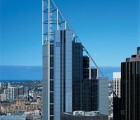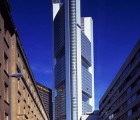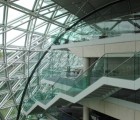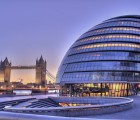Norman Foster highlighted buildings, influences and style

Born in 1935 in Reddish (United Kingdom)
Architectural style and influences of Norman Foster
Norman Foster, a British architect, is known for his innovative and forward-thinking architectural style that combines modernist principles with cutting-edge technology and sustainability. Here are some key characteristics of Norman Foster's architectural style:
High-Tech Modernism
Foster's architectural style is often associated with high-tech modernism, characterized by a focus on technological innovation, efficiency, and functionality. His designs often feature clean lines, geometric forms, and a minimalist aesthetic. Foster's buildings are sleek, precise, and often incorporate advanced engineering and construction techniques.
Transparency and Light
One of Foster's trademarks is his use of glass to create buildings that are transparent, light-filled, and visually striking. He often employs large expanses of glass walls, curtain walls, and skylights to maximize natural light and create a sense of openness. This transparency blurs the boundaries between indoor and outdoor spaces, connecting occupants with their surroundings.
Structural Expressionism
Foster's buildings often express their structural systems in a bold and visible way. He celebrates the inherent strength and beauty of materials such as steel and glass, using them to create innovative structural solutions. This can be seen in the exposed beams, trusses, and columns that define many of his designs.
Sustainable Design
Foster is a pioneer in sustainable architecture, integrating energy-efficient systems and environmentally friendly features into his buildings. He is known for his commitment to sustainability, using passive design strategies, renewable energy sources, and green building materials to create environmentally responsible structures.
Contextual Sensitivity
While Foster's designs are undeniably modern, he also pays careful attention to the context of each project. He considers factors such as the site's history, culture, climate, and urban environment, aiming to create buildings that respond harmoniously to their surroundings. This contextual sensitivity results in buildings that are not only visually striking but also respectful of their context.
Iconic Roof Designs
Foster is renowned for his innovative roof designs, which often become iconic elements of his buildings. From the soaring glass roof of the Reichstag in Berlin to the distinctive dome of the British Museum's Great Court, Foster's roofs are both functional and sculptural, adding a sense of drama and identity to his designs.
Flexibility and Adaptability
Foster designs his buildings with flexibility and adaptability in mind, anticipating future needs and changing uses. His designs often include modular elements, movable partitions, and flexible floor plans that allow spaces to be easily reconfigured over time.
Iconic Works
Some of Norman Foster's most iconic works include the Gherkin (30 St Mary Axe) in London, a sleek and distinctive skyscraper with a unique tapered form; the Hearst Tower in New York City, a modernist tower with a striking diagonal grid facade; and the Millau Viaduct in France, a stunning bridge that spans the Tarn River valley with graceful elegance.
Norman Foster's architectural style is characterized by a blend of high-tech modernism, transparency, sustainability, structural expressionism, and contextual sensitivity. His buildings are not only visually striking but also functional, efficient, and designed to adapt to the changing needs of society. Foster's innovative designs have left a lasting mark on the world of architecture, inspiring future generations of architects and pushing the boundaries of what is possible in the built environment.
Highlighted buildings of Norman Foster:
-
Beijing Capital International Airport (Beijing)
-
Deutsche Bank Place (Sydney)
-
Bilbao Metro (Bilbao)
The Metro Bilbao was designed by the renowned British architectural firm Foster and Partners, led by architect Norman Foster.
Foster's design for Metro Bilbao features a modern and efficient metro system that reflects the industrial heritage of Bilbao while incorporating contemporary design elements.
The stations of Metro Bilbao are known for their clean lines, use of glass, steel, and concrete, and a sense of spaciousness and efficiency.
-
Commerzbank Tower (Frankfurt)
-
Faculty of Law (Cambridge)
The Faculty of Law building, designed by the renowned British architect Norman Foster, is a striking example of modernist architecture located in Cambridge, United Kingdom. Officially known as the "Sir Joseph Hotung Building," it serves as the home of the Faculty of Law at the University of Cambridge. Here are some details about the architecture of this impressive structure:
Context and Design Concept:
Norman Foster's design for the Faculty of Law building was completed in 1995, and it...

-
London City Hall (London)
London City Hall, officially known as the "City Hall" or "The Greater London Authority Building," is a distinctive and iconic structure located on the South Bank of the River Thames in London, United Kingdom. Designed by the renowned British architect Norman Foster of Foster + Partners, the building serves as the headquarters of the Greater London Authority (GLA) and the Mayor of London. Here are some details about the architecture of this remarkable building:
Design Concept:






 Santiago Calatrava
Santiago Calatrava  Benedetta Tagliabue
Benedetta Tagliabue  César Pelli
César Pelli  Frank Gehry
Frank Gehry  Gustave Eiffel
Gustave Eiffel  Hiroshi Hara
Hiroshi Hara 